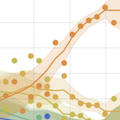Abstract
This report details current seasonal influenza circulation patterns as of early February 2024 and was prepared for the Northern Hemisphere VCM on Feb 15, 2024. This is not meant as a comprehensive report, but is instead intended as particular observations that we’ve made that may be of relevance. Please also note that observed patterns reflect the GISAID database and may not be entirely representative of underlying dynamics. Influenza circulation as well as surveillance continues to be strongly affected by our response to the SARS-CoV-2 pandemic over the past three years. Data are hence expected to be biased and predictions particularly uncertain. All analyses are based on the nextflu/nextstrain pipeline with continual updates posted to nextstrain.org/flu. In compliance with data sharing agreements, this public version of the report does not include raw serological measurements.
A/H1N1pdm: H1N1pdm sequence counts have grown rapidly in the last two months in Europe and North America. HA clades C.1, C.1.1.1, and C.1.7 compete regionally without a clear forerunner. C.1’s recent success in Europe appears driven by its NA clade C.5 with NA:S200N substitution. C.1.1.1 and C.1.7 continue to diversify and circulate outside of their original dominant countries (USA and Australia). Recurrent substitutions appear at HA1 sites 120, 142, and 152 across most recent clades, but none of these appear associated with antigenic drift. Ferret serology suggests that the current vaccines, A/Wisconsin/67/2022 and A/Sydney/5/2021, cover all extant clades. Human serology based on recent vaccination with A/Wisconsin/588/2019 also shows little antigenic drift for any clades.
A/H3N2: H3N2 counts are growing rapidly in West Asia and Europe, after a quiet 2023. Clade H has likely fixed globally and has diversified into four new clades H.1, H.2, H.3, and H.4. H.2 has circulated at the highest frequency potentially due to its loss of a glycosylation site at HA1:122 and an antigenic escape substitution at HA1:276E. Ferret serology suggests that H.2 maybe drifted from the H-descendant vaccine A/Massachusetts/18/2022, while A/Darwin/6/2021 continues to cover recent H strains. Human serology also suggest that vaccination with A/Darwin/6/2021 may protect against recent H strains.
B/Vic: In the last six months, B/Victoria has been sequenced primarily in North America. Sequence counts remain relatively low compared to the peak season in Europe last February and March. Clade C.5 has nearly fixed globally and diversified into subclades including several with recurrent HA1:197E and HA1:183K substitutions. The current vaccine strain, B/Austria/1359417/2021 (basal in C), continues to effectively cover clade C strains observed in the last year.
